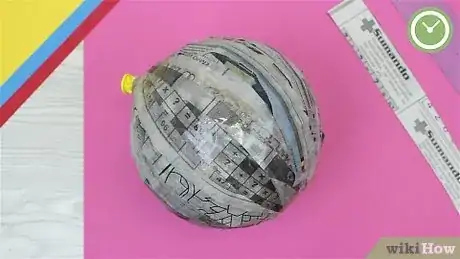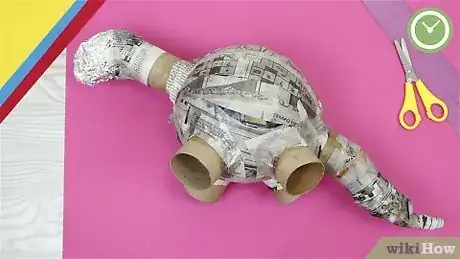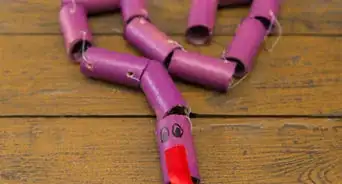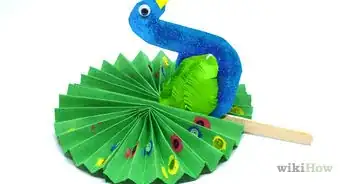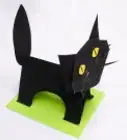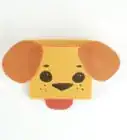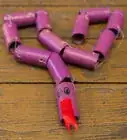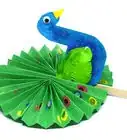This article was co-authored by wikiHow Staff. Our trained team of editors and researchers validate articles for accuracy and comprehensiveness. wikiHow's Content Management Team carefully monitors the work from our editorial staff to ensure that each article is backed by trusted research and meets our high quality standards.
The wikiHow Video Team also followed the article's instructions and verified that they work.
This article has been viewed 49,555 times.
Learn more...
With the right supplies and a bit of time, you can make your very own paper dinosaur that stands or moves. If you'd like a bigger craft project, you could even attempt a paper mache dinosaur or an origami dinosaur! Depending on the colors that you use, you can make your dinosaur look realistic or cartoonish.
Steps
Creating a Cartoon Puppet Dino
-
1Glue a sheet of green construction paper to a piece of thin cardboard. This will make your dinosaur nice and sturdy. If you don’t have any green construction paper, paint the cardboard with green acrylics or poster paint. Let the glue or paint dry before moving on.[1]
- The thin cardboard from cereal and snack boxes works great for this!
- If you don’t have thin cardboard or construction paper, try green cardstock instead. You can also use poster paper, but you’ll need to paint it.
-
2Draw and cut the body, head, tail, and leg shapes from the paper. Look up coloring book or cartoon pictures of long-necked dinosaurs, then break it down into separate body parts. Draw these separately with a pen or pencil, then cut them out. Here are the basic shapes you’ll need:[2]
- A long stem with an oval-shaped head, like a brontosaurus or apatosaurus
- A long, tapering tail, like a skinny triangle
- 2 rectangular legs
- A mound- or lump- shaped body, like a semicircle but with rounded bottom corners.
Advertisement -
3Make spikes for the dino's back using paper and cardboard if desired. Glue the paper to the cardboard first (or paint the cardboard). Let the paint or glue dry, then draw 4 to 5 triangular spikes. Cut them out, then set them aside.[3]
- Use a different color of paint or paper for this. Orange is a great choice, but a lighter or darker shade of green will also work.
- You can also make smaller rectangles for nails.
-
4Use a pen to poke a hole in the ends of each limb. Make the holes 1⁄4 to 1⁄2 in (0.64 to 1.27 cm) away from the center of each edge. A pen or pencil will work just fine for a cardstock dino, but if you used thin cardboard, use a nail to make the holes instead.[4]
- You’ll need holes in the following areas: base of the neck, base of the tail, and the top of each leg.
- Don’t use a hole punch. The hole will be too big and the brad will fall through.
- If you're a child, ask an adult to help you with this step, especially if you're using a nail.
-
5Poke 4 holes in the body so that you can secure the limbs. Make 2 holes along the wider, flatter, bottom edge of the body. Poke another set of holes on the sides of the body for the tail and legs. As with the limbs, make the holes 1⁄4 to 1⁄2 in (0.64 to 1.27 cm) from the edges.[5]
- Don’t poke the neck and tail holes too close to the top; make them closer to the bottom so that your dinosaur has a humped back.
- Don’t place the legs too close together. Keep them closer to the bottom corners of the body.
-
6Use brads to secure the limbs behind the dinosaur's body. Stick a brad through the front of the neck hole on the body. Slide the neck piece onto the back of the prong, behind the body. Pry open the back of the brad, then press the prongs flat against the back of the dinosaur.[6]
- Repeat this step for the tail and both legs. Always add the limbs to the back of the body, not the front.
- Make sure that the limbs are facing up as well, otherwise your dinosaur won’t match!
- Brad prongs can hurt if they get under your nail. Consider using a butter knife to pry them apart.
-
7Glue the spikes to the back of the dinosaur. Flip the dinosaur over so that you can see the back. Draw a line of glue along its back, then add the triangular spikes. Make sure that the flat bases are touching the dinosaur's back while the pointy tips are sticking out.[7]
- If you made nails for the dino, glue them to the bottom of each leg.
- White school glue and glue sticks will work just fine for this. Hot glue is not recommended because it's too bulky.
-
8Give the dinosaur a face. Here is where you can get a little creative. For a simple dinosaur, use a black marker to draw an eye and mouth. For a fancier dinosaur, use hot glue or white school glue to attach a googly eye to the dinosaur's face.[8]
- Give your dinosaur more character by adding eyebrows or eyelashes.
Making a Long-Necked 3D Dino
-
1Fold and cut a plain white paper plate in half with scissors. Fold the plate in half first, then use the crease as a cutting guide. For best results, use the kind that's made from cardstock and has a frilled edge, rather than the kind that's made from thick cardboard with a rim.[9]
- Set aside 1 of the paper plate halves; this will make the body.
-
2Cut a dino head, tail, and spikes from the other paper plate half. Draw the shapes on the second paper plate half (the other one will be the body), then cut them out. Make sure that the limbs are proportionate to the body. Don't worry about the feet; you will be using toilet paper rolls for that.[10]
- Make the spikes about 1 in (2.5 cm) tall and wide.
- Make the tail about 1 to 2 in (2.5 to 5.1 cm) wide at the base, and about 1/2 to 2/3 the length of the paper plate.
- If you don't know how to draw a dinosaur head, tail, or spikes, look at pictures of cartoon dinosaurs online or in coloring books.
- Use the brim to make the neck, if desired. Cut it off first so that you get a C-shape, then cut it in half. Use 1 of these halves to make the neck.
-
3Glue the cut shapes to the other paper plate half. The straight edge of the plate is the bottom of the dinosaur, while the curved side is the back. Glue the tail to 1 end and the neck and/or head to the other. If you made spikes, glue them down the dinosaur's back.[11]
-
4Use scissors to cut an empty toilet paper roll into thirds. Keep 2 of the segments and discard the third. This will give you rings that are a little over 1 in (2.5 cm) tall. If you don't have any empty toilet paper rolls, you can use an empty paper towel roll instead.[12]
- If you're using an empty paper towel roll, cut 2 1 to 2 in (2.5 to 5.1 cm) segments from it.
-
5Cut a set of slits into the top of each toilet paper ring. You will be sliding the dinosaur's body into these slits, so make sure that they are directly across from each other. The easiest way to do this would be to squish the rings in half, then cut a 1⁄2 in (1.3 cm) long slit into each one.[13]
-
6Slide the dinosaur into the slits. Take the first roll, and turn it so that 1 slit is facing the dinosaur's head and the other is facing its tail. Slide the bottom edge of the dinosaur's body into the slit. Repeat this process for the other leg.[14]
- Slide the legs apart until they are on opposite sides of the plate.
-
7Paint the dinosaur, then let it dry. Acrylic craft paints will work great for this, but you can also use poster paint too! Use the same colors and patterns for both the front and back. How long it will take for the paint to dry depends on what you are using. Expect to wait about 15 to 20 minutes, however.[15]
- You can take the dinosaur's body off of its feet in order to paint it. Do the front first, let it dry, then do the back.
- Don't forget to paint the eyes and mouth! Alternatively, you can glue on some googly eyes after the paint has dried.
Building a Papier-Mâché Dino
-
1Blow up a balloon, tear newspaper into strips, and make a papier-mâché paste. Blow up a balloon to your desired size. Next, tear some newspaper into narrow strips, about 1 by 3 in (2.5 by 7.6 cm). Lastly, prepare your preferred papier-mâché glue or paste.[16]
- The most popular papier-mâché paste is just 1 part water and 1 part PVA glue (white school glue).
- Start with just 1 or 2 sheets of newspaper; you can always make more strips.
- Don't cut the strips, or the edges will be too sharp and create creases. Tearing them will give you a smoother finish.
-
2Dip the strips into the paste, then apply them to the balloon. Run each strip of newspaper between your fingers after dipping it in the paste; this will remove any excess glue. Make sure that the strips are all going in the same direction as you apply them.[17]
- Overlap the strips a little, such as by 1⁄4 to 1⁄2 in (0.64 to 1.27 cm).
- Keep the balloon in a cup or bowl so that it doesn't roll around. You may have to let 1 side of the balloon dry first before doing the other.
- Leave a coin-sized space at one end of the balloon exposed so that you can pop the balloon later.
-
3Apply 2 more layers of papier-mâché. You probably don't need to use the glue for the second layer; the wet strips already adhered to the balloon should be enough for the new ones to stick to. If the balloon starts to get too soggy, however, let it dry a bit, then continue working.
- Consider using white tissue paper for as a fourth and final layer. This will give you a smoother base and help the paint show up better.
- If you choose to use tissue paper, then make sure that you tear it into 3 by 1 in (7.6 by 2.5 cm) strips as well.
-
4Let the strips dry overnight, then pop and remove the balloon. You may have to wait even longer than that, depending on how dry or humid it is in your home. In fact, it would be a good idea to poke your finger under the papier-mâché; if it feels wet, give it a little more time.[18]
- This completes your dinosaur's body.
- Don't worry about the hole left by the balloon. You'll end up covering it with the dinosaur's head or tail.
-
5Tape paper towel roll segments to the balloon for legs. Turn the papier-mâché balloon on its side, then use masking tape to secure the legs to the bottom.[19]
- Don't use clear tape; it won't stick to the papier-mâché.
- You can also just cut 2 empty toilet paper rolls in half and use those instead.
-
6Use cardboard, paper towel tubes, and foil to make the other limbs. Scrunch up aluminum foil into a ball to make a head, and then use aluminum foil shaped into a cone for the tail. The size and shape for each depends on what type of dinosaur that you're making, so look at some reference pictures. Here are some more ideas to get you started:[20]
- Triceratops: cut a round, scalloped shape out of cardboard for the fan. Use foil to make the horns.
- Stegosaurus: cut triangles out of cardboard for the fins.
- Apatosaurus/brontosaurus: use a paper towel tube to make the neck.
-
7Tape the pieces to the body with masking tape. Take 1 of your pieces, and hold it against the balloon where you want it to go. Secure it with strips of masking tape until the seam is completely hidden. Again, don't use clear tape, because it won't hold.
- Triceratops: tape the fan to the balloon first, then add the head (you may have to use hot glue to secure it). Finish by sticking the horns to the head.
- Stegosaurus: tape or hot glue the head to 1 side of the body and the tail to the other. Use strips of tape to add the fins down the back and tail.
- Apatosaurus/brontosaurus: tape the head to the long neck first, then tape the head to the body. Add the tail to the other side of the body.
-
8Cover the pieces and the seams with more papier-mâché. Start by applying strips of papier-mâché to the seams. After that, cover the shapes themselves. If the pieces feel unstable, add more papier-mâché to the seams.[21]
- You may have to tear more strips of newspaper and prepare more papier-mâché paste for this.
- Consider making some smaller strips for sharp curves and tight corners.
- If the hole from when you removed the balloon is still visible, cover it up with more papier-mâché.
-
9Wait for everything to dry. How long it will take for your project to dry really depends on what the weather is like. Papier-mâché will dry a lot faster on a hot, dry, sunny day than on a cold, wet, day. Be patient![22]
-
10Paint the dinosaur as desired, then let the paint dry. Acrylic craft paint will work just fine for this, but you can use poster paint too. You can use realistic colors for your dinosaur, like gray, brown, and green, or you can use fantasy colors, like pink, purple, and blue.[23]
- For a nicer finish, paint the dinosaur white first, then let the paint dry. This will give you a clean "canvas" to work on.
- Don't forget to add eyes and a mouth. You can paint the eyes, or glue googly eyes on instead.
- How long it will take for the paint to dry will depend on what type of paint you're using. Plan to wait about 15 to 20 minutes, however.
Community Q&A
-
QuestionCan I make a dinosaur park like Jurassic World?
 Community AnswerYes. You have to first learn how to make different species, but you could make a park.
Community AnswerYes. You have to first learn how to make different species, but you could make a park.
Things You'll Need
Creating a Cartoon Puppet Dino
- Green construction paper
- Orange construction paper
- Glue stick
- Thin cardboard
- 4 brads
- Pen or nail
- Scissors
- White school glue (optional)
- Googly eye (optional)
Making a Long-Necked 3D Dino
- White paper plate
- Empty toilet paper roll
- Scissors
- Green acrylic paint or poster paint
- Glue stick or white school glue
Building a Papier-Mâché Dino
- White school glue
- Newspaper
- Balloon
- Cardboard
- Aluminum foil
- Empty toilet paper rolls
- Masking tape
- Acrylic paint or poster paint
- Scissors
References
- ↑ https://craftsbyamanda.com/movable-dinosaur-craft/
- ↑ https://craftsbyamanda.com/movable-dinosaur-craft/
- ↑ https://craftsbyamanda.com/movable-dinosaur-craft/
- ↑ https://craftsbyamanda.com/movable-dinosaur-craft/
- ↑ https://craftsbyamanda.com/movable-dinosaur-craft/
- ↑ https://craftsbyamanda.com/movable-dinosaur-craft/
- ↑ https://craftsbyamanda.com/movable-dinosaur-craft/
- ↑ https://craftsbyamanda.com/movable-dinosaur-craft/
- ↑ https://www.goodtoknow.co.uk/family/things-to-do/how-to-make-a-paper-dinosaur-107682
- ↑ https://www.goodtoknow.co.uk/family/things-to-do/how-to-make-a-paper-dinosaur-107682
- ↑ https://www.goodtoknow.co.uk/family/things-to-do/how-to-make-a-paper-dinosaur-107682
- ↑ https://www.goodtoknow.co.uk/family/things-to-do/how-to-make-a-paper-dinosaur-107682
- ↑ https://www.goodtoknow.co.uk/family/things-to-do/how-to-make-a-paper-dinosaur-107682
- ↑ https://www.goodtoknow.co.uk/family/things-to-do/how-to-make-a-paper-dinosaur-107682
- ↑ https://www.goodtoknow.co.uk/family/things-to-do/how-to-make-a-paper-dinosaur-107682
- ↑ https://www.redtedart.com/kids-crafts-paper-mache-dino-bank/
- ↑ https://www.redtedart.com/kids-crafts-paper-mache-dino-bank/
- ↑ https://www.redtedart.com/kids-crafts-paper-mache-dino-bank/
- ↑ https://www.redtedart.com/kids-crafts-paper-mache-dino-bank/
- ↑ https://www.redtedart.com/kids-crafts-paper-mache-dino-bank/
- ↑ https://www.redtedart.com/kids-crafts-paper-mache-dino-bank/
- ↑ https://www.persil.com/uk/dirt-is-good/arts-crafts/how-to-make-paper-mache-dinosaurs-step-by-step.html
- ↑ https://www.persil.com/uk/dirt-is-good/arts-crafts/how-to-make-paper-mache-dinosaurs-step-by-step.html
About This Article
To make a paper dinosaur, start by gluing a green piece of construction paper to a piece of cardboard. Then, draw and cut out the body, head, tail, and leg shapes for the kind of dinosaur you want to make. Next, poke a hole at the base of the head and tail, at the top of each leg, and at the base of the body where each leg will attach to it. Finally, insert brads into the holes to connect all of the parts of your dinosaur together. To learn how to make a papier mache dinosaur, scroll down!
